#and the quay and the history
Explore tagged Tumblr posts
Text
.
#I know I'm really biased#but I really love my home city#it's just so pretty and there's old stone buildings#and little cobble alleyways with cafés tucked into#and the quay and the history#I know to an outsider that it probably is kinda rubbish#but I love it
5 notes
·
View notes
Photo
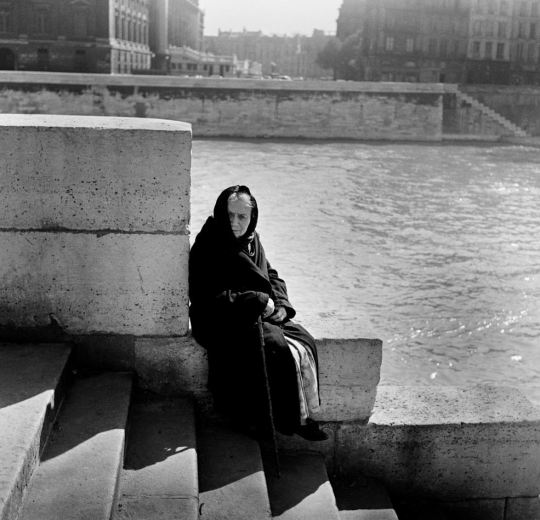
Sitting on the Quay, Seine, Paris, 1949
#elderly#quai de seine#seine#quay#quai de la seine#historic#history#vintage#black and white#tore johnson#street scene#streetscape#the seine#paris#france#swedish
491 notes
·
View notes
Text
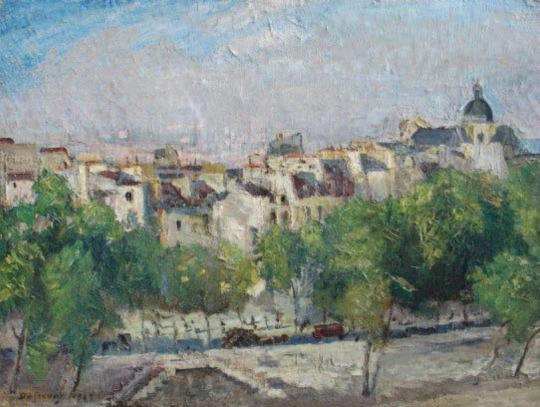
Georges Dufrenoy (1870 - 1943)
"Paris, Quai de l'hôtel de ville"
75 x 101 cm - Huile sur carton 1917
#dufrenoy#postimpressionism#art#georgesdufrenoy#artist#artistepeintre#artoftheday#artwork#painting#oilpainting#parismaville#hotel de ville#paysage#paysageurbain#urban landscape#landscapearchitecture#seine#quai#art history#artiste peintre#artists on tumblr#art collection#artiste#oil painting#paint#peinturealhuile#peintre#parisjetaime
21 notes
·
View notes
Text
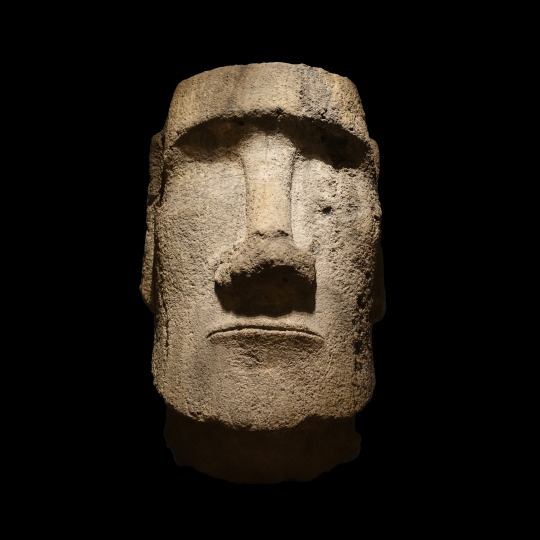
Moai Head, Chile, Between circa 1250 and circa 1500,
Basalt, H 170 cm (66.9 in) , W 100 cm (39.3 in), Thick 90 cm (35.4 in)
Collection Musée du Quai Branly, Paris.
#art#history#design#style#archeology#sculpture#antiquity#figure#moai#head#basalt#musée du quai branly#rapa nui#easter island
51 notes
·
View notes
Text
pra mim isso aqui grita "eu sou uma pessoa rasa que quer se pagar de inteligente mas na realidade eu não dou a mínima nem pra arte, nem pra história, nem pro contexto em que a arte é posta e feita" tipo.... para de ser tão ignorante ou em primeiro lugar nem posta uma coisa dessas 🙃mas que coisa

#sim objetivamente todas elas tem uma diferença de detalhes gritante#mas você pelo menos se deu ao trabalho de entender o porquê que essas obras eram feitas em primeiro lugar?#quais eram os padrões colocados como ideais ou algo assim?#e além de tudo isso se você é letrado nesse assunto e mesmo assim tem essa opinião não tem problema até pq você tem um lugar de fala ne...#mas sendo uma pessoa X falando isso acho um pouco revoltante#bla bla bla#traditional art#art history#modern art#art critic
2 notes
·
View notes
Text
Welcome to
🇯🇵Elliott's Japan Trivia Corner!🇯🇵
Where you can learn random stuff about Edo-era Japan (and sometimes other periods) from your local neurodivergent nerd ✌️✨️
.
So y'all have heard of Kabuki right? If you haven't, it was the more popular form of theatre during Edo (by opposition to the more intellectual nō theatre), and it's got awesome makeup and fun flashy costumes.
Like a lot of cool things, it was created by women, who where then slowly driven out of it by men 🙃 But it was also super queer! 🏳️🌈🏳️⚧️
Kabuki originated from female travelling entertainers, then later welcomed male actors. Plays mostly happened in the pleasure districts, and they eventually kinda merged with prostitution. Long story short, if theatre-goers really fancied one of the actresses, they could go home with her for a reasonable fee 💸
The shogun, who didn't like many things and especially did not like fun, decided that this was unacceptable. And that the best course of action was obviously to ban women from performing kabuki.
Wanna guess what happened ?
That's right. The exact same thing continued, but with male prostitutes instead 👍 Good job, shogun.
Male actors playing female roles were called onnagata, and they were considered an ideal of feminine grace and beauty, that all the Edo-era women tried to copy. Which, if you've ever been to a drag show, is pretty understandable imho 💅
(Some onnagata apparently stayed in feminine attire even off-stage, which I personally cannot interpret differently than "Me? 🏳️⚧️Trans🏳️⚧️?? Noooooo, you misunderstand, I'm just reeeaaallyyy into method acting! 🤞")
#sources from wikipedia; from an exhibit on kimono fashion at the Quai Branly museum; and from Linfamy on youtube#hope you enjoyed this because there WILL be more posts like this ✌️#i am reading a book about edo era japan and so far ive dog-eared like a third of all the pages#elliott's japan trivia corner#japan#japanese history#kabuki#kabuki theatre#edo era
25 notes
·
View notes
Text
#OTD in Irish History | 14 July:
In the Liturgical calendar, it is the Feast Day of Idus of Leinster, an Irish saint of the fifth century. He is said to be a disciple of Saint Patrick, who baptised him, he was made bishop of Alt-Fadha in Leinster by Patrick. 1749 – Birth of Matthew Lyon in Co Wicklow. Lyon attended school in Dublin, before emigrating to America where he worked as a printer, farmer, soldier and politician,…

View On WordPress
#irelandinspires#irishhistory#OTD#14 July#1798 United Irishmen Rebellion#Co Wexforc#Dublin#History#History of Ireland#IRA#Ireland#Irish Civil War#Irish History#Irish War of Independence#Kilmore Quay#Saltee Islands#St. George&039;s Channel#The Troubles#Today in Irish History
15 notes
·
View notes
Note
do you think ludinus has that crystal quay recorded or do you think he possibly got a hold of patia’s orb? those are the only two things I can think of that would’ve mentioned laerryn and lasted long enough to be found
Honestly I would be shocked if he had either. The orb seems like it would be the most likely candidate to earn a reappearance if one of the EXU Calamity artifacts were going to, but I doubt Ludinus would be the one to have it.
#and as much as i would like to see it#with the trajectory the hell's are taking right now#i doubt we're going to see anything which is fine#i'm also not sure i think quay's crystal made it out#i do like the idea of it from like... a historical angle#like and forgive me i'm paraphrasing but quay saying that history isn't really true because it's all about what people decide to make publi#so it's just a really good example of how unreliable history is if quay's story is the way her name gets into history books#but like this is also just the me obsessed with exu calamity talking#not what i realistically think would make it into a campaign#erin answers things#anonymous
5 notes
·
View notes
Text



Leamington Lift Bridge.
Pics of and from the bridge.
Built in 1906, the bridge is constructed from a wooden deck that can be raised between two gantries to give a clearance of 9 feet (2.7 m) below.
The bridge was installed around 1906 where Fountainbridge crossed the canal replacing a previous bridge built in 1869, at that time it was close to Chalmers Buildings where I used to live When the canal was shortened in 1922 to make Lochrin Basin the terminus it was moved to its present site
Whilst the bridge is not open to cars, there is a lattice girder footbridge which allows pedestrians to cross when the deck is raised for boats, this is where I took the third pic from.
In 2018, the bridge required an internal inspection and assessment to determine the current structural condition. Based on the outcomes of the inspection, essential work was required to replace certain sections of the bridge.
16 notes
·
View notes
Photo

In the heart of Gdańsk, where the River Motława whispers secrets from centuries past, the narrow, winding streets are shrouded in a veil of mystery. Each vibrant, gabled house stands like a guardian of untold stories, draped in shadows that dance under the soft glow of street lamps. As twilight descends, the echoes of ancient merchants linger, their laughter blending with the gentle lapping of the river against weathered quays. Paint this enigmatic cityscape, where the illustrious architecture reflects a rich tapestry of resilience and romanticism, and the ethereal mist cradles the spirit of its storied history.
#Gdańsk#Motława#mystery#streets#architecture#twilight#river#history#merchants#shadows#stories#resilience#romanticism#cityscape#secrets#vibrant#echoes#mist#lamps#quays#vivid
0 notes
Text

Bordeaux
#france#bordeaux#city#les quais#waterfront#garonne#river#travel#history#photography#digital camera#plants#urban#gothic#neoclassic
1 note
·
View note
Text
Mexica, les trésors du Templo Mayo dévoilés au Quai Branly !
Le musée du quai Branly - Jacques Chirac dévoile en ce moment une merveilleuse exposition retraçant l’histoire des Mexica (intitulée Mexica, des dons et des dieux au Templo Mayor). Ce peuple, installé connu sous le nom d’Aztèques, est présenté sous un jour nouveau. C’est le terreaux fertile d’une découverte inédite la cité de Tenochtitlan, détruite par les colons espagnols. Grâce à un regard aiguisé construit avec près de cinquante années de recherches archéologiques sur cette histoire mésoaméricaine, l’exposition retrace les travaux focalisés sur la culture, l’art ou encore l’architecture de cette civilisation.
Ces recherches, effectuées par des professionnels passionnés, sont présentées dans un parcours dense et particulièrement riche. Organisée avec le concours de l’Institut national d’anthropologie et d’histoire de Mexico (INAH), l’exposition comporte plusieurs thématiques qui permettent d’envisager le peuple Mexica avec beaucoup de curiosité.
La visite débute par le visionnage d’une vidéo qui a pour but d’introduire le contexte historique qui donne d’importantes clés de compréhension aux visiteurs. Particulièrement dense en informations, dates et personnages historiques, la vidéo peut s’avérer difficile à appréhender. Tout débute dans les années 1970 lorsque des trésors archéologiques sont découverts, c’est le Templo Mayor, lieu emblématique de cette civilisation qui refait surface. Mais pas d’inquiétude, la suite de l’exposition développe grand nombre de ces points dans un dédale de cartels d’exposition, d’objets et de cartes.
Utiliser des vidéos dans le cadre d’expositions à thématiques historiques permet d’introduire ou d’approfondir des sujets dans un format alliant plusieurs supports. En effet, le visuel joue un rôle prépondérant et souvent permet au public de se souvenir de certaines choses marquantes. La narration orale joue aussi dans la retention d’informations. Les vidéos sont présentes à plusieurs moments de l’exposition et traitent de multiples manières des archives Mexica. On y retrouve donc des explications historiques (comme évoqué précédemment), mais aussi des entretiens issus des chercheurs se focalisant sur le Templo Mayor ou de courtes vidéos sur des exemples de sacrifices.
L’objectif de cette publication n’est pas de vous divulguer la totalité des supports de médiations proposés par l’équipe derrière la muséographie et les nombreuses installations. Je souhaite évoquer un support particulièrement marquant quant à son contenu, mais aussi par rapport à sa forme.
Le calendrier rituel, appelé « Tonalpohualli », a une place de choix dans le voyage proposé par le quai Branly. Une grande reproduction dudit calendrier occupe l’espace comme une imposante statue au centre d’une pièce et se trouve placée devant deux écrans, présentant les explications des informations gravées à même la pierre. L’installation permet de comprendre les éléments charnières du calendrier tout en découvrant certaines déités et croyances des Mexica. La narration accompagnée de ce jeu de lumières et vidéo permet une immersion dans cet univers qui m’était inconnu.
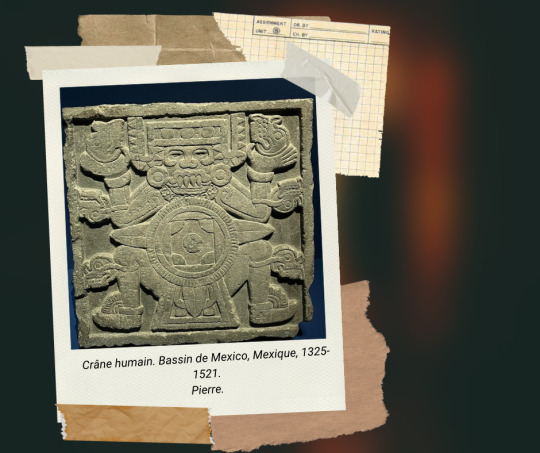
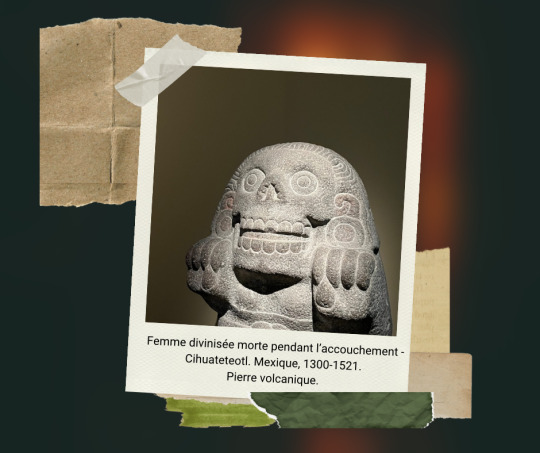
Il serait dommage de ne pas mentionner l’importance donnée à tous les objets retrouvés au Templo Mayor présentés dans ce parcours. Vitrines, et présentoirs interviennent en simultanée avec les sculptures, cartes et graphiques pour ériger un circuit d’exposition étoffé. Assurément, une cohésion est présente. La société Mexica accordait une valeur indéniable aux symboles et à leur capacité fédératrice dans sa culture. On retrouve beaucoup de pierres volcaniques, mais aussi des bijoux dans un bel état de conservation, des métaux travaillés et des sculptures à l’effigie des dieux craints comme adulés. Pour approfondir ce point, les sacrifices humain étaient constituants dans une partie des rites présentés. Et l’exposition présente plusieurs récipients creusés dans des pierres monumentales utilisées pour récolter le sang, certains organes ou les os des sacrifiés. De fait, certains éléments sous vitrines peuvent choquer les publics non-avertis ou les plus jeunes. Ces sacrifices étaient réalisés pour pléthore de raisons, que je vous laisse découvrir.
Enfin, je souhaitais également souligner le rôle essentiel des cartels d’information présents tout au long du parcours tant il donne à chacun des détails nécessaires à la compréhension des outils, objets, sacrifices, coutumes et croyances présentés. Je ne peux que vous encourager à y mettre les pieds et à ouvrir votre curiosité à ce bout d’histoire de l’Amérique, c’est jusqu’au dimanche 08 septembre 2024 !
Chloé Schaeffer. Billet publié le 30/04/2024.

#Mexica#Quai branly#Musée#Paris#Sorties#ChloeHistoire#Histoirededire#Culture#Histoire#History#Mexico
0 notes
Text
Things from IWTV episode 10 (s2ep03) I noticed:
- the French is good this time! I still wonder if it's the actors themselves or dubbing. But it's actually understandable for a French-native person, and the language itself is exquisite. Wondering now if those lines are picked up from the book in Anne Rice's own pen, the translation of the books, or they're original lines written for the show by a French writer who has a splendid style.
- I just really loved the Armand flashback, both because of the language, and because it opens up the veil on the history of vampire covens throughout the centuries. Also we get to see more Lestat, this time Armand's Lestat and that's always a win.
- Armand is right about both Louis being broken and Claudia being pushed to the limits of how long she can accept this life of hers. I absolutely do not trust Armand, he's twisting the narrative for his own purpose (that I don't know because I haven't read the books yet), but still, he's a good judge of character. Can't not be one and survive for 500+ years I guess.
- the Loustat scenes, on the quai de Seine, in the bar and in the park, were insane.
- was that Sartre? Did. Did they just cameo'd in Sartre for the lols? Man, Paris.
- speaking of Paris, I know it was actually filmed in Prague, but man, I felt like I was back there. That Seine promenade, that's the one I walked countless times in my years living there. I could recognise the pavements like I was still there.
- Santiago's fed uppppp with Louis' BS. And he's definitely laughing at Claudia. Calling her "puce"... It's funny because in French, "ma puce" is a term of endearment, like "my darling", but indeed literally it means "my flea", so for an English-native like Claudia, it could be seen as literally being called the smallest, lowest member of the coven (like Delainey says in the episode insider), but for a French-native, it's like the coven is calling her sweetheart. And then they give her that dress and tell her she's going to play a kid for the bext 50 years, the one thing she hates being reminded of the most, and you go "ooooh. Oh, no, honey. They bad. This is bad." Clau's about to Break. Knowing how her story goes, I'm not sure I'm ready for that.
- Danny boy felt subdued this time. Like he's still reeling from Louis' invasion in the last episode, and now that Talamasca agent invading his laptop, he's feeling attacked on all sides and he's floundering to get back up again. That said, the scene with just him and Armand was particularly intense. You can sense how yearning Armand is, and how destabilised Daniel feels under Armand's gaze. In other words, that vampire really wanna fuck that old guy, and the old guy doesn't know how to feel about it but he's definitely feeling the intensity.
Need to read those books yesterday.
#rapha talks#rapha watches shows#interview with the vampire#iwtv s2#amc iwtv#iwtv spoilers#iwtv no pain#louis de pointe du lac#lestat de lioncourt#armand the vampire#daniel molloy#claudia de pointe du lac#loustat#loumand#armand x daniel#armandiel#armandaniel#(what's the actual generally accepted ship name for these two you can't tell me there's no consensus for a canon ship#that's been in existence for actual decades?)
167 notes
·
View notes
Text
"Blah blah blah Laerryn's only record in history ever is from Ludinus blah blah blah how tragic blah blah blah history forgot her blah blah blah"
I'M SORRY EXCUSE ME YOU THINK LOQUATIUS SEELIE DID JUST ONE RECORDING TALKING ABOUT LAERRYN??? YOU THINK IT'S JUST THOSE LAST ONES IN HIS LAST 12H OF LIFE???
YOU'LL TRY AND CONVINCE ME HE DIDN'T LEAVE A TRAIL ACROSS EXANDRIA OF HIS LOVE FOR THIS WOMAN!?
YOU THINK NOT EVEN ONE EXANDRIAN HISTORIAN FOUND HIS YEARS OF REPORTING HE DID ACROSS THE PLANET AND YOU THINK NOT ONCE HE MENTIONED THE MOST BEAUTIFUL WOMAN IN THE WORLD HIS IMMEASURABLY BRILLIANT WIFE
LAERRYN WANTED TO BE REMEMBERED AND DAMN IF QUAY DIDN'T MAKE SURE OF THAT
#cr spoilers#loquaerryn#laerryn coramar seelie#loquatius seelie#I REFUSE TO BELIEVE THAT#We knew them for 24h and he spent it with his thoughts wrapped around her#and that was divorced and frustrated at each other and the circumstances#can you imagine that man at the high of his passion#he would've mentioned and praised and shown off this woman at every fucking opportunity#when someone as bright as Loquatius loves u. one cannot remain in shadow#i have so many feelings about this changeling#exu calamity
1K notes
·
View notes
Text
Indigenous people welcome return of 16th-17th century cloak to Brazil
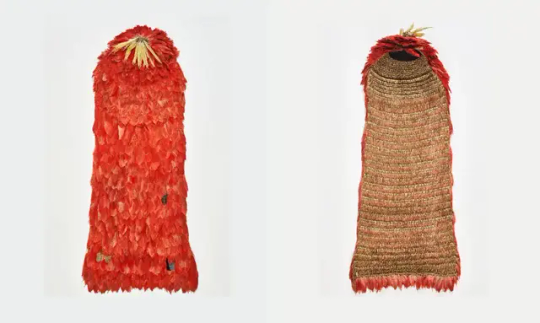
The return of a Tupinambá cloak made from red guará bird feathers to Brazil, after more than three centuries in storage in Denmark, was a reason for celebration among the indigenous people in southern Bahia. The Danish National Museum donated the artifact to the National Museum in Rio de Janeiro.
The Brazilian museum confirmed the cloak's arrival on July 11 and announced plans to exhibit the piece in the coming weeks.
However, ten other similar cloaks, also made from guará feathers, remain in European museums, according to a survey by American researcher Amy Buono from Chapman University in California, USA.
According to the research, there are four more cloaks in the National Museum of Denmark, in addition to the one that was returned to Brazil. The Natural History Museum of the University of Florence, Italy, holds two others. Additionally, Tupinambá cloaks can be found in the Museum of Cultures in Basel, Switzerland; the Royal Museum of Art and History in Brussels, Belgium; the Quai Branly Museum in Paris, France; and the Ambrosian Library in Milan, Italy.
Continue reading.
#brazil#brazilian politics#politics#indigenous rights#denmark#museums#image description in alt#mod nise da silveira
47 notes
·
View notes
Text
🇯🇵Elliott's Japan Trivia Corner🇯🇵
is back baby!
On the topic of kabuki theater (see also: male actors in female roles, the result of a shogun's ill advised attempt at limiting prostitution)
There's this dude called Ichikawa Danjuro VII, whom I find absolutely ✨fantastic✨.
👑The guy was very popular, a trend-setter, highly admired among the people of Edo, and apparently the greatest actor of his century. He was also 💖BFFs💖 with the most popular ukio-e (woodblock prints) artist of the time, and was portrayed on hundreds of ukio-e (they were kinda like celebrity magazines or collectible cards at the time).
👘Ichikawa was well known (among other things) for his signature kimono, that he wore onstage. It was embroidered with sickles, circles, and the character ぬ (nu), which put together read "kawamanu" : "I don't give a shit".
He was eventually banished from Edo for... -drumroll- dressing too fancy.
(Edo-era Japan had strict castes, with specific dress codes enforced by sumptuary laws; which the lower classes found new creative ways to circumvent every time the shogun passed a new one 😎)
#elliott's japan trivia corner#sources are wikipedia and that one exhibit about kimonos at the Quai Branly museum#the world of kabuki and ukio-e and urban middle-class the culture of edo is very funny to me#*the urban middle class#they were obsessed with celebrities and bought woodblock prints depicting their famous actors going about their daily lives#like paparazzi photos but drawn#another actor of the ichikawa lineage once played a role that involved being immerged in a bucked of cold water#the water was afterward sold for a gigantic price to enamoured fans#people have always been people <3#history#kabuki theatre#ichikawa danjuro vii
12 notes
·
View notes